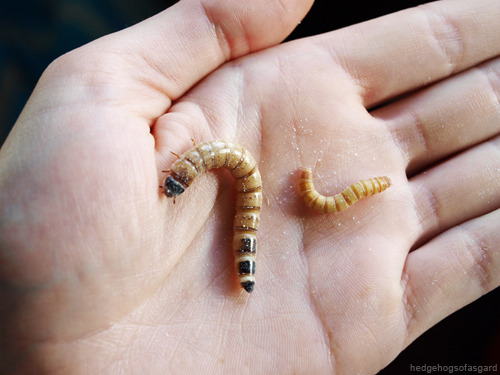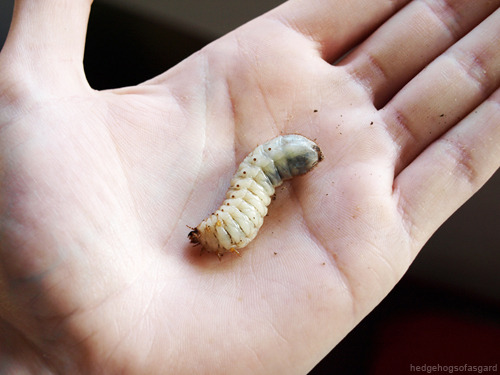Can I Feed My Hedgehog Fries Dried Crickets
Feeder insects for hedgehogs

Hedgehogs are omnivorous animals by nature but most of their diet consists of insects. While they're not going to die if you don't feed them insects, I personally think it's an important part of their diet given their menu in the wild. And most hedgehogs absolutely love them! Some hedgehogs just won't eat insects, but don't give up when your hedgie ignores them the first couple of times. It can take up to a few weeks and several tries (or even longer) before they get they're edible, especially when they are not used to it - but once they've tried them, they'll go nuts for it!
Some hedgehogs don't like taking new treats straight from you. Leave the insects in their food bowl during the night instead.
I never feed insects straight from my hands; I leave them in their bowls or use tweezers for the sake of my fingers. You don't want your hedgie accidentally chomping down on you in their enthusiasm!

Live, freeze dried or canned?
Some people don't like squirmy bugs but live insects are definitely the best option, so your hedgehog could be a good excuse to overcome your fear! They are more nutritious since you can gut load them before feeding, and they're fresh. Freeze dried insects like mealworms can cause constipation, so feed them in moderation.
Store bought or wild caught?
It is not recommended to feed wild caught insects to your hedgehog. These can contain parasites and pesticides. You can buy live insects in lots of pet stores and there are webshops who sell them online.
Breeding your own insects is cheaper and not that hard (with most species). You can find lots of caresheets and tips online!
Take good care of your insects and give them enough food and water before feeding them to your hedgehog. Otherwise it's just an empty snack.
Suitable feeder insects
Here are some common (and less common) feeder insects with pictures.
Mealworm (Tenebrio molitor, on the right) and superworm (Zophobas morio)

Probably one of the most well-known feeder insects, mealworms are easy to keep and easy to breed. If you don't want them to pupate it's best to keep them refrigerated. This will slow down their metabolism. It's very easy to breed your own mealworms if you keep them at room temperature. Hedgehogs can eat the pupae and beetles as well.
Superworms look like giant mealworms and are harder to breed since they are less likely to pupate. Some people cut off the head before feeding them since they have pretty strong jaws.
Both mealworms and superworms are quite high in fat so if your hedgehog has trouble staying slim you shouldn't feed too many meal/superworms.
House cricket (Acheta domesticus)

Another common feeder insect. This one is a great treat for hedgehogs since they are low in fat and most hedgehogs love hunting for crickets. They are easy to keep and easy to breed (at room temperature, or slightly higher). Crickets can be quite noisy!
They are available in different sizes so they are suitable for young hedgehogs as well.
Jamaican Field cricket and Black field cricket (Gryllus assimilis/Gryllus bimaculatus)

About the same size as the house cricket, but they are not so fast and jumpy. While assimilis is a pretty silent cricket, bimaculatus has one of the loudest calls.
They need higher temperatures in order to breed.
Both crickets in the pictures above are young ones.
Dubia roach (Blaptica dubia)

Probably the best feeder insect for hedgehogs together with crickets since they are low in fat. The Dubia roach is a tropical roach (so if they escape their enclosure they won't survive) and needs to be kept at a minimum of 68 F. It should be warmer if you want them to breed. They breed pretty easily, don't smell and make no sound. They can't climb either so it's hard for them to escape if you keep them in a glass tank or plastic tub.
Desert locust (Schistocerca gregaria)

A big insect, low in fat so suitable for every hedgehog although they are too big for young ones. They are quite hard to breed, need higher temperatures and it can be harder to gut load them since they only eat grass and plants.
Waxworm (Galleria mellonella)

These are the larvae of the Greater wax moth. They are high in fat and should be fed as an occasional treat only. You can keep them at room temperature or in the refrigerator so they don't pupate.
Phoenix worm/calcium worm (Hermetia illucens)

There are several names for the larvae of the Black soldier fly but the most common one seems to be "Phoenix worm". They are very rich in calcium and not too high in fat (somewhere in between crickets and mealworms). They also contain high levels of lauric acid, which is known to kill viruses and bacteria. These larvae are suitable for every hedgehog and a great option for smaller hedgies who need a low fat treat.
Butterworm (Chilecomadia moorei)

These "worms" are actually the larvae of the moth Chilecomadia moorei. They have a bit of a fruity/buttery scent, hence the name.
Since these moths are considered a pest outside their native Chile, the larvae are irradiated before being exported so they cannot grow into moths and breed. They're best kept refrigerated.
These larvae are high in fat and should only be fed as an occasional treat.
Sun beetle (Pachnoda marginata peregrina)

The larvae of the sun beetle are quite big and really high in fat. They should only be fed as an occasional treat - it's like giving your hedgehog a big bag of fries.
The beetles they turn into cannot be fed since they excrete a nasty tasting fluid when threatened, but they can be kept as pets and are easy to care for and very pretty! They need higher temperatures to breed and pupate.
They have strong jaws so it might be good to cut off the head before feeding them to your hedgehog.
Dendrobena (Dendrobena veneta)

Mainly used as a composting worm and as fishing bait, they should be kept at (low) room temperature. They're low in fat and soft, so they make a nice treat next to insects like crickets and roaches.
Source: https://hedgehogsofasgard.tumblr.com/post/86720781951/feeder-insects-for-hedgehogs
Postar um comentário for "Can I Feed My Hedgehog Fries Dried Crickets"